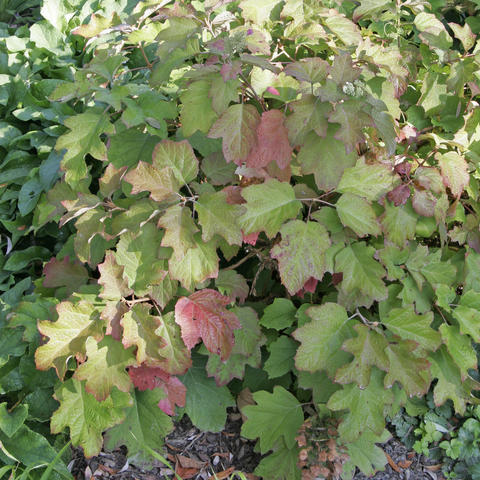Oakleaf Hydrangea
The Oakleaf Hydrangea highlights summers with white flower panicles and the autumn with flaming foliage in an elegant and charming way.
Factsheet
- Growth type
-
- shrub
- Growth height (from)
- from 100 cm to 150 cm
- Growth width (from)
- from 100 cm to 150 cm
- Growth characteristics
-
- upright
- bushy
- Flower color
-
- white
- Flowering time (month)
-
- July to August
- Flower shape
-
- Panicules
- Flower characteristics
-
- sterile
- Leaf color
-
- green
- page format
-
- 3-7 lobes
- lobbed
- oblong
- oval
- Sheet properties
-
- Autumn coloring
- Light
-
- sunny to semi-shade
- Soil type
-
- sandy to loamy
- Soil Moisture
-
- fresh to humid
- ph value
-
- neutral to weakly acidic
- Lime compatibility
-
- lime-tolerant
- Nutrient requirements
-
- nutrient-rich
- Humus
-
- rich in humus
- Decorative or utility value
-
- Flower Decoration
- Leaf ornaments
- Nectar or pollen plant
- Winter Hardness
-
- hardy
- Climate zones according to USDA
-
- 7
- Use
-
- Single position
- Rebates
- Garden style
-
- cottage garden
- Flower garden
- Japanese Garden
- natural garden
- Bee Friendly
- bee friendly plant
The Oakleaf Hydrangea (Hydrangea quercifolia) is native to southeastern North America. There it grows in dry forests.
The Oakleaf Hydrangea is an upright shrub up to one and a half meters high, which is as wide as it is tall once it is a mature plant. The annual growth is up to 11.81 inches. The reddish, felt-like hairy shoots are striking. Root runners sometimes form on maturation.
The name says it all: The semi-evergreen foliage of the Oakleaf Hydrangea differs greatly from that of other Hydrangeas. Hydrangea – instead it reminds you of the Northern Red Oak (Quercus rubra). The 3.93 to 7.87 inches long and almost as wide leaves are present on long stalks, are oblong-oval in shape and have coarse, unevenly shaped lobes that are three, five or seven in number. The underside is gray-green and has a gray felt-like texture, while the upper side is deep green and appears a bit wrinkled. The autumn colors are simply magnificent: Then the whole shrub shines in varieties of orange to red to auburn.
In midsummer, between July and August, the 3.93 to 9.84 inches long and almost as wide white panicles of flowers open, which then fade to a dull pink. Large-flowered varieties in particular tend to have their flowers turned slightly towards the ground, while small-flowered varieties remain upright.

The flowers are sterile, so there is no fruiting.
Hydrangea Quercifolia would like to be planted in a sunny to at most partially shaded location, preferably slightly protected from cold winds and frost - then the leaves will remain the shoots for most of the winter.
The Oakleaf Hydrangea needs plenty of water. Like so many others, they hate waterlogging in the ground. Hydrangea Quercifolia prefers humus, a pH value in the weakly acidic to neutral range. Of all Hydrangeas it tolerates lime best. Supplying the shrub with a lot of nutrients results in late lignification, which makes it sensitive to early frosts.
Hydrangea quercifolia can be planted from fall to spring - provided there is no frost. The planting hole should be about twice as big as the root ball. If required, waterlogging should be avoided as much as possible by drainage through coarse sand. You can improve the topsoil with plenty of humus-rich substrate.
Good water supply is essential for these plants. In spring, it is ideal to supply the Oakleaf Hydrangea with compost or horn shavings. A layer of mulch in the root area ensures a cool base.
Pruning is only recommended when necessary, the Oakleaf Hydrangea has a naturally harmonious growth. It is enough to remove dead flowers and cut out frozen shoots in spring. Note: Hydrangea Quercifolia blooms on old wood, so please do not prune the flowering plants!
The Oakleaf Hydrangea can withstand up to -4 degrees Fahrenheit. New shoots in particular benefit from winter protection in rough regions, as they sometimes lignify late.
Be it in cottage gardens, cottage gardens orJapanese gardens: Hydrangea blends in harmoniously everywhere. Be it as a stand-alone plant or in a group with Amur Maples and Witch-Hazel, accompanied by perennials such as purple bells and cranesbills, on the edge of the pond or even in a pot: Its positive features are expressed in many ways. It is also ideal as a bee pasture!

The variety 'Snowflake' is characterized by double white flowers, which turn reddish in fall. And “Burgundy” remains a bit smaller with about 59 inches, the variety blooms in flat, white pseudo-panicles. With less than 39 inches height, “Pee Wee” is tiny with compact growth and white flowers. Later the color changes to red-purple. “Harmony” impresses with its extremely voluminous and dense white flower umbels that turn red in autumn. This variety is relatively tall. Hydrangea quercifolia ‘Applause’ looks exotic due to its leaves with strongly protruding veins. There are also many other vibrant varieties - unfortunately, they have not yet been sighted.
Propagation of the Oakleaf Hydrangea is ideally done using cuttings in July. To do this, cut off green shoots without flowers and divide them into sections, each with a pair of leaves above and below. The bottom leaves are snipped off, the upper leaves are pruned to reduce evaporation.
Plant diseases, fungal infestation and other pests are not known.



